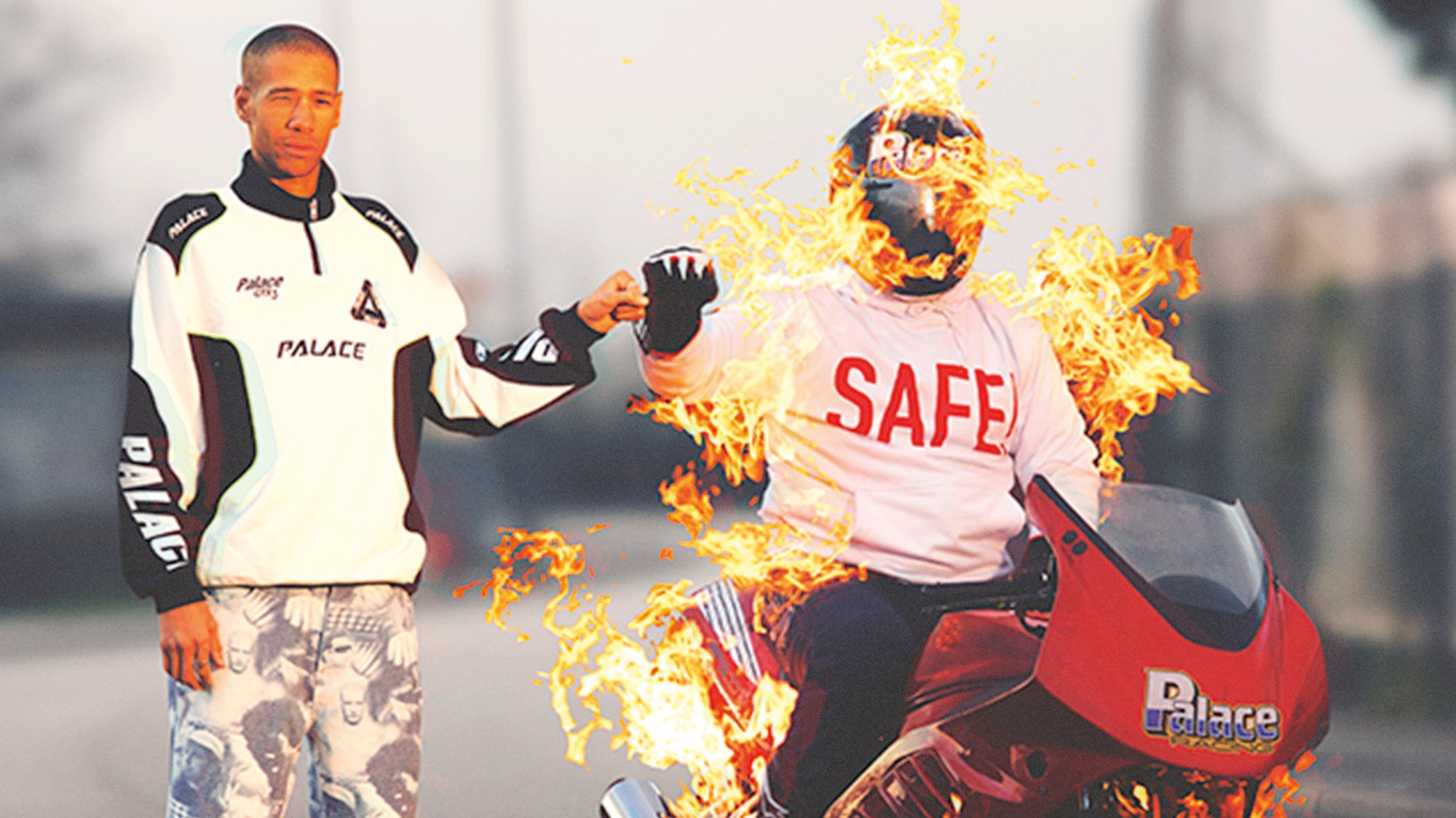This article appears in i-D’s The Homegrown Issue, no. 355, Spring 2019. On newsstands from 25 February. For more exclusive images pre-order here.
In 2019, Palace hits the grand old age of 10. To celebrate one of British streetwear’s biggest success stories, Paul Flynn sits down with Palace founder Lev Tanju to discuss the blood, sweat and beers that went into building the brand we know and love. While David Sims shoots a portfolio of the people who’ve defined one of men’s fashion’s homegrown success stories.
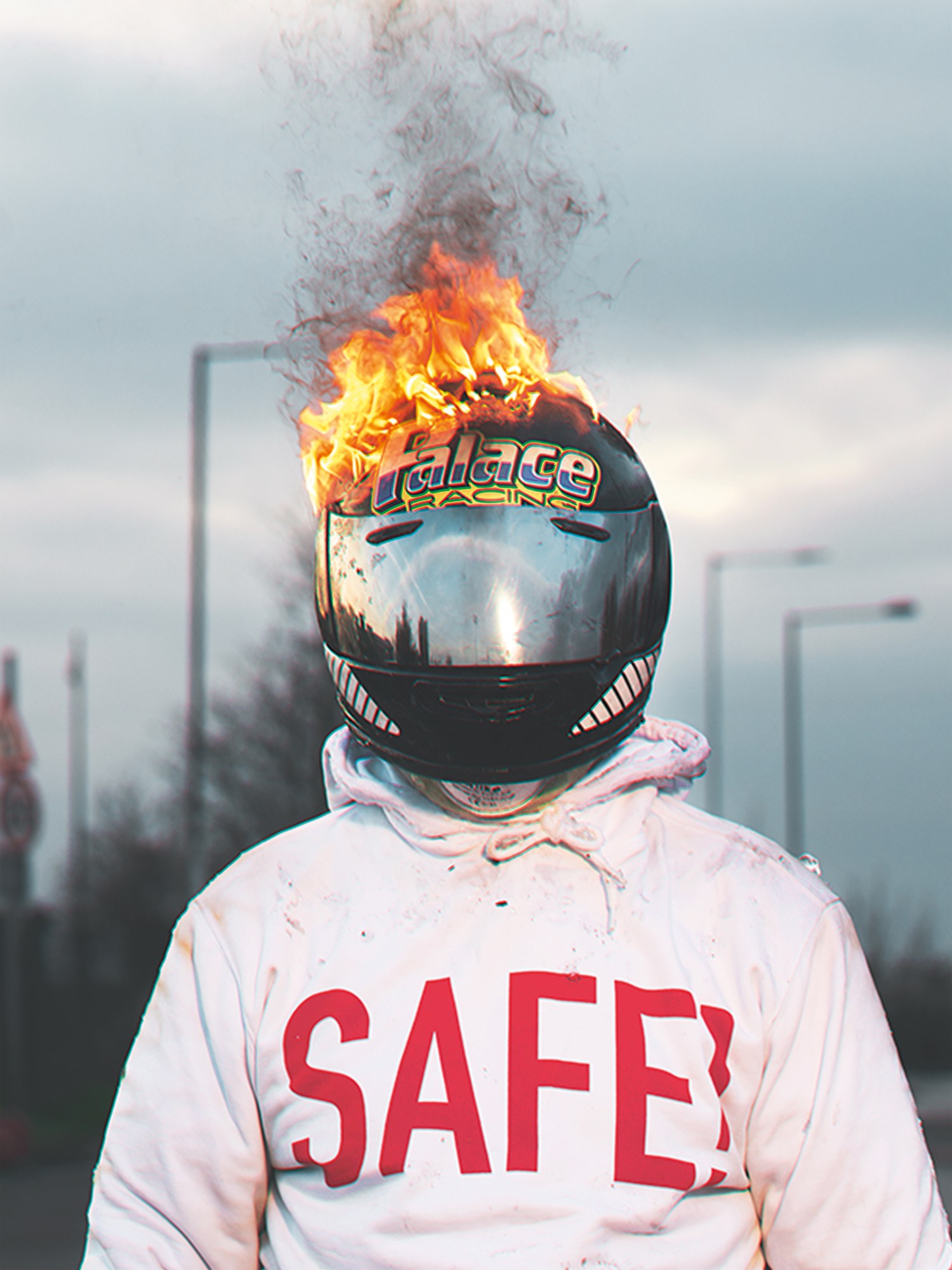
When browsing the rails of the Brewer Street Palace store in spring 2017, the skateboard label’s devoted disciples happened upon a single racked T-shirt. Sitting alongside the familiarly failsafe edit of baseball caps, cagoules, penny loafers, track-wear, signet rings, button downs, slacks and boards, it didn’t stay in the shop long. The T-shirt bore an image of Elton John in all his plumage: big hair, big jewels and diamante jacket, hammering away at his piano. With deft photoshop trickery, the two lenses of Elton’s fabulous sunspecs had their arms extended, morphing into two of the brand’s signature Ps, as if having a conversation with one another.
The item became an instantly covetable Palace classic: cheeky, British, funny, lavish and street. It brushed some of the outer edges of good taste Palace occasionally likes to tickle, to test the brand’s originality, demography and audacity. The raw appeal of Palace lies somewhere between its rock-solid eye for clothes men want to wear and the idiosyncratic playfulness it can bring to them.
As with everything in the Palace lexicon, the Elton T-shirt came from a place of sincerity. A British skateboard label with global weight was never meant to happen. You only get there by teetering toward the edges of acceptability and enjoying yourself along the way.
On the label’s website, the advertising caption underneath read: ‘I don’t have much money but boy if I did/I’d kill Ellie Goulding and smoke a large spliff’, a reference to the singer’s soporific recent cover version of Elton’s evergreen classic for a John Lewis Christmas advert. Goulding had been rumoured to have sang Your Song in another iconic London Palace (Buckingham) at the nuptials of Prince William and the first civilian Royal, Kate Middleton. The high and low conjoined. London, retail, royalty, wit and good times. Peel away every visual signal thrown out from the house of Palace – the neoclassical pissing statue in its New York store, the badge of honour silver shopping bags, the Rolls Royce grill wall-mounted in the Brewer Street branch – and a pleasing backstory emerges.
At the time of writing, one of the Palace/Elton T-shirts is selling for £299.99 on eBay. Two years ago, it retailed for 35 quid, an entrepreneurial mark-up of almost 900% for one canny online dealer. By the time of reading it will be gone, another fleeting footnote in the best yellow brick road story in British menswear of the last decade.
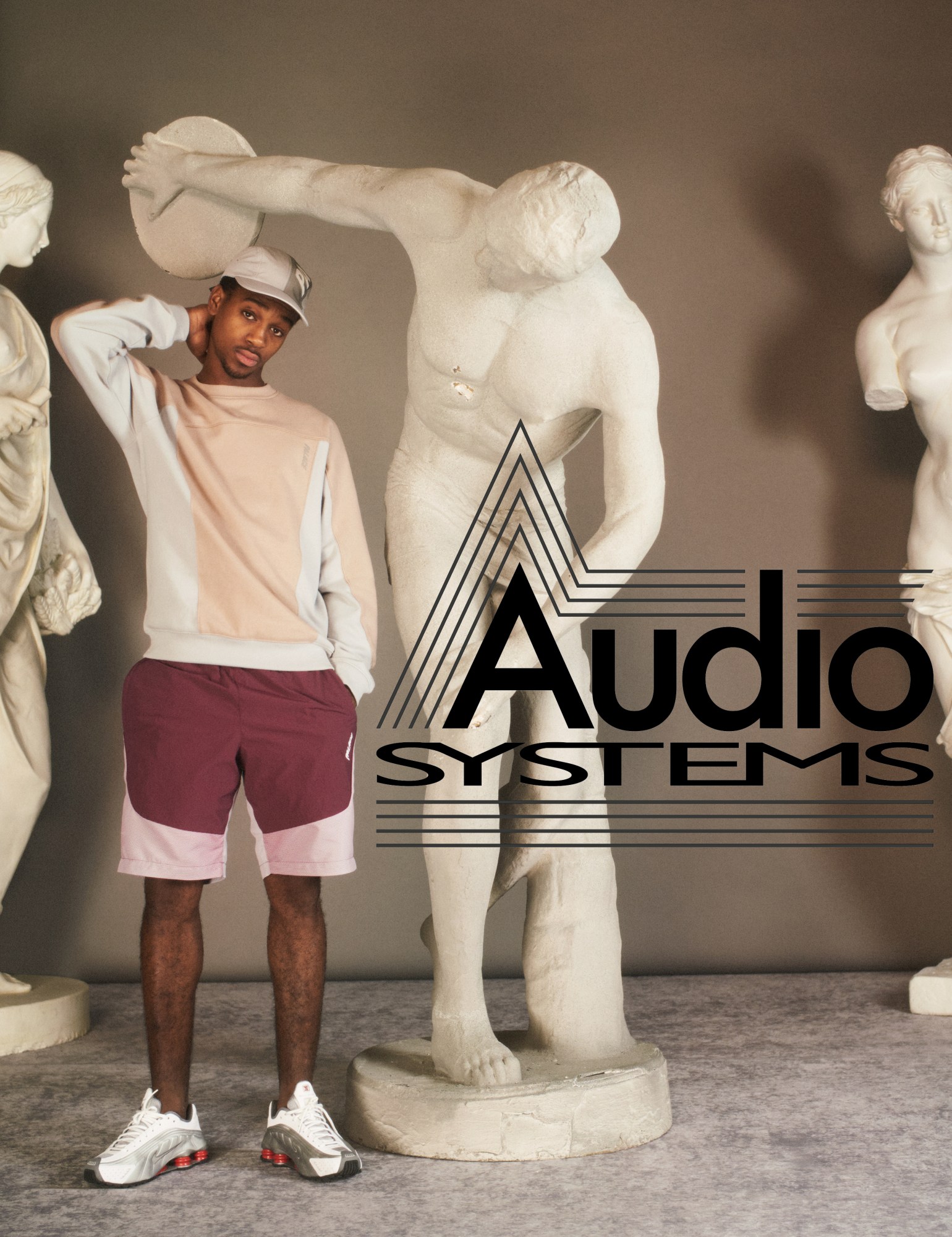
In 2019, Palace hits the grand old age of 10. It is not just fashion’s favourite menswear label. During its lifespan, without so much as a stumble or sidestep, the global reach of Palace has matched its fanciful early ambition. When it first appeared, if any professional game-plan loomed over its red-hot supply and demand chain, it seemed to have been sketched out roughly on the back of a Rizla packet by some scruffy lunatic at South Bank’s skate park.
Palace began as a brand for skateboarders. It is now a brand for all. Models turn up for castings in Palace. Working class Glasgow dads sport Palace. Jay-Z wears Palace. So does Rihanna. Teenage girls sleep in Palace, dreaming of the heart-throbs they’ve seen wearing Palace online. 2018’s Wimbledon finalists played on court in Palace. Soundcloud rappers adore Palace. The ICA exhibits Palace. Serious DJs with peerless techno collections adorn their record boxes with Palace stickers. Ravers ingest ecstasy pills produced in the shape of Palace’s Tri-Ferg logo. Socio-political causes, including the plights of both Jeremy Corbyn and the people of Palestine, have been smartly memed in versions of the Palace triangle.
A middle-aged architect can slyly intimate he has better kids than his colleagues by picking something up at Palace, even if it’s just their socks. Virgil Abloh and Marc Jacobs wear Palace. London tube station walls are adorned by carriage-length adverts for Palace. Palace has a shop in Tokyo to match the heavyweights in London and New York. The bigwigs at Ralph Lauren were so taken by the irrepressible rise of Palace that Palace became its first ever collaborator in 50 years of singularly myth-making fashion history.
Fashion’s favourite photographers Alasdair McLellan, Juergen Teller and David Sims shoot for Palace. Silicon Valley is full of people in Palace. Blue-chip stylists buy Palace from their own pocket money to lend their imagery some of the company’s off-rail styles and indigenous London magic. i-D and British Vogue carry Palace ads. Madonna and child (Rocco) have been photographed proudly wearing Palace. All the while, a fat lad on a Midlands housing estate is looking great and feeling even greater in Palace while waiting for his Chinese takeaway and playing Fortnite.
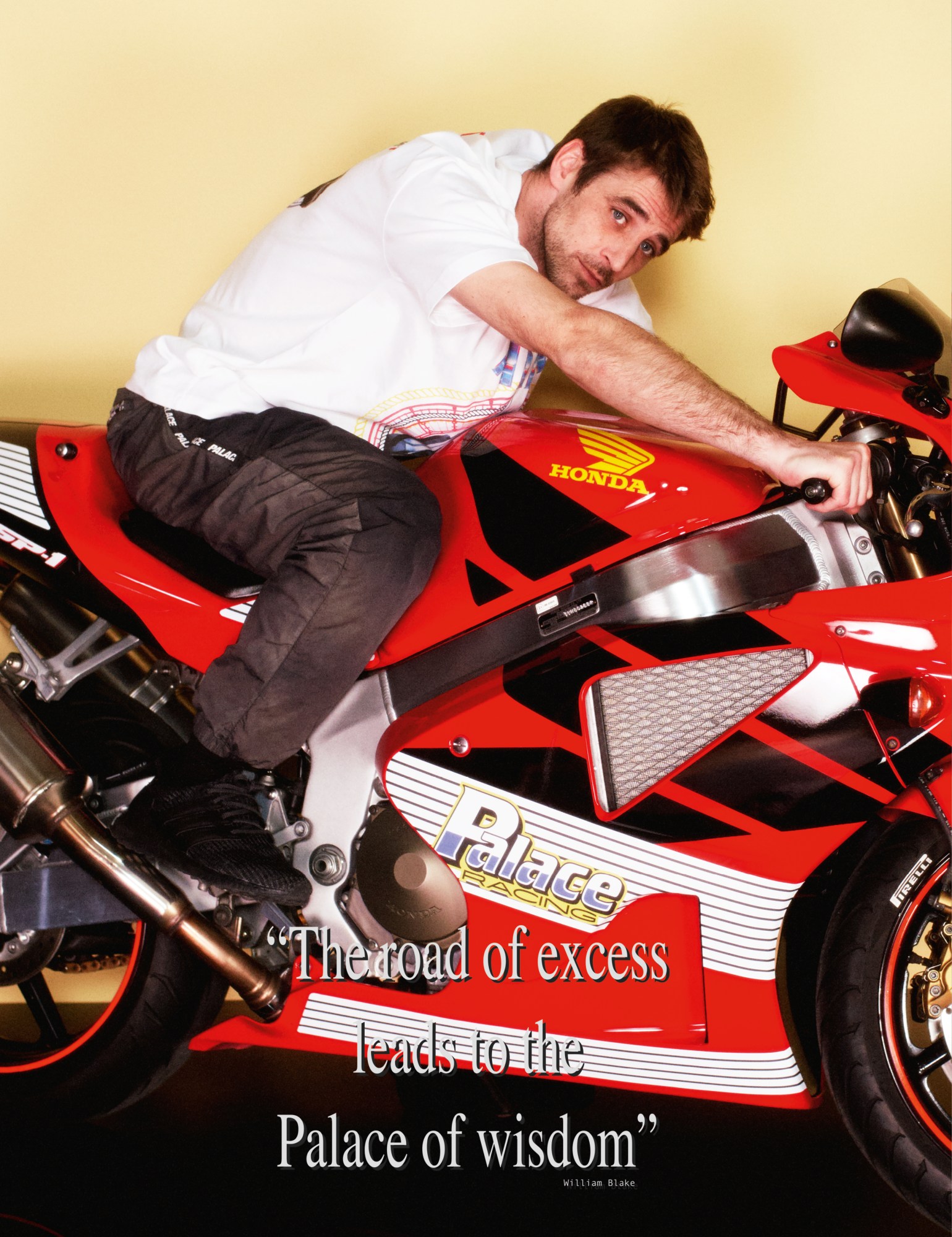
Palace has performed the unthinkable. Like Stone Island, Stüssy and Supreme before it, Palace is the menswear upsetter that can make the flash and cash of the big houses feel fussy, unfocussed and out of touch. Unlike its formidable forebears, Palace is a homegrown success story. Underneath its enviable reach, there is a heart-warming love letter being scripted to the country of its origin. Palace has made Britishness, in all its brilliantly ratchet, gnarly, self-aggrandising, nonsensical and amazing glory look like the best place on earth, precisely at the time it couldn’t feel less like it.
“We didn’t want to make a big thing about the 10 years,” says Palace founder Lev Tanju, sitting in one of his perennial favourite Bloomsbury Italian restaurants. “We didn’t want to blow smoke up our own arses.” A half-eaten plate of filleted dover sole and a casual lunchtime bottle of Laurent Perrier blush sit in front of him. “It’s only ten years. Some shit brands have been going for 60.” He smiles. “It ain’t rocket science, mate.”
Presenting British youth culture at its most dynamic was always Palace’s greatest sleight of hand, the ace up its sleeve. “It’s not a trick because it’s in everyone’s face,” Lev says. “It’s just a question of looking out for it. The culture here is the most important and fucking amazing in the world. I just breathe it in. I’m so proud to be from London. This city is banging. There’s no fake bullshit. This city oozes culture, realness, happy people, sad people, even the c*nts all add to it.”
Transposing the culture around him to the shop floor was always the dream. “That’s the only thing Palace was. We were true to London. We’re not trying to be anything we’re not. We’re not saying fuck you, this is cool. Like it or lump it. It’s basically representing London in a way that it’s supposed to be represented. We’re honest.”
Lev Tanju, and by extension Palace is not a tricky puzzle that needs solving. “I’m a simple man,” he says, “living in the best city in the best country in the world.”

Lev Tanju took to skateboarding late. He was 18 when he first tripped along to the South Bank skate park, alone. “My best mate at school got a skateboard. I thought it was the coolest shit ever and I just copied him.” He was a quick learner. “I got infatuated in some next level way. Watching videos constantly, 24/7, learning this thing, this art.”
He is a naturally gregarious, open-handed sort. “I love things,” he says. “I’m passionate rather than obsessive. When I love things, I want to know all about them. I want to meet people who know about them. I respect people that know about the things I love.”
He was first introduced to the ideological concept of what a British skateboard family might look and feel like when he moved into a dilapidated walk-up beside another Italian restaurant, above a Greggs bakery on Lower Marsh, at the back of Waterloo Station in his early 20s. “It was sketchy,” he says, “an absolute shit-hole.” For £100 a month, an inconceivable rental bonanza in today’s London, he couldn’t expect much more. The first thing he did on moving in was to buy a miniature pet blue lobster, who he called Larry.
The house, a rotating sleepover for skaters from around the country, was falling to pieces. Dubbing it ‘The Palace’ was a verbal act of young irony and pride. A posh girl staying over for the night with an intermittent tenant once went to the kitchen to find water and was greeted by the site of a lone pot of caviar and a bottle of Prosecco in the fridge. (“Which we’d nicked, obviously.”) Skateboards lined the stairways up to the bedrooms. One shoulder could barge the front door open. The boys lived off £1 Sainsburys microwaveable roast dinners.
For fear of a rental hike, a plumber was only called after four months of the residents of the Palace showering with sparks in front of their eyes. The tradesman identified a leak from the bathroom down to the fuse box in the kitchen. “He took a pencil from behind his ear, pointed at the damage and told us we were lucky we weren’t dead.” They rectified the problem by taping a shower curtain over the leak.
Everyone passing through the flat became entrenched in one another’s lives. The gang first called themselves Palace Wayward Boys Choir and some of the Palace lifers still sport PWBC tattoos in an assortment of fonts. A family of skilled, elegant, daring skaters, dreaming of becoming pros, related by the genealogy of wheels not blood, began to bond. They took full advantage of living within easy walking distance of “free booze parties” midweek just across the Thames and would light up a room by walking into it. Given the opportunity, they would skate all day, every day.

The first Palace collection consisted of two T-shirts, one nicking the iconic Versace Medusa’s head graphic that Lev himself designed, another emblazoned with the original Palace logo, the endless Penrose triangle designed by his great friend, the capital’s master graphics craftsman, Fergus Purcell, who had previously worked on branding for two successful labels, Silas and Tonite. “Which I loved,” Lev says. “Fergus is my fucking idol. We’d go to house parties and do mushrooms with him.”
Fergus carries about him an air of mystical psychedelic positivity and good vibrations, a skateboarding shaman, a graphically gifted Gandalf the Grey. “I respected him deeply, loved all his graphics and his T-shirts. He’s a fucking genius, man. I’m honoured to even be sat working with him, spending this much time working on Palace. He’s the king of graphics. There is no-one like him and I’ve said it a million times. He’s influenced everyone.”
Another friend and skater, Will Bankhead designed skateboards, one featuring a goat-head man, one with Stella, another Palace resident and skater Joey Pressey’s dog, and one with Bonnie Prince Billy, the Kentucky singer who records for his own label, Palace Recordings. It was the only international touch. The first shop to place an order was The Hideout, the much-loved, much lamented executive streetwear shop off Golden Square in Soho owned by London’s guru of industrious street retail, Michael Kopelman. “That was like, woah,” Lev remembers.
Palace established itself quickly and effectively in the London consciousness. Because the mainstream media has no apparent interest in skateboard culture, they were lent an instantly subversive, countercultural cachet that brands spend a lifetime trying to weave into their heritage. Because of the instant selective familiarity of YouTube, the brilliant videos Lev made of his mates skateboarding built a viral fanbase early, only adding to the market value of this exciting young enterprise in London menswear.
Larry the lobster lasted four years at the original Palace. Lev Tanju lasted ten. He’d like to see a blue plaque above the door one day. Maybe it will happen. Maybe Fergus will get to design it. “How do you do that even?” he asks. “That’d be so good, man. That would be banging.” By the time he moved out, the rent had risen to a mere £130 a month. “We worked out that we’d basically saved about 50 grand from living there.” A brand was born.
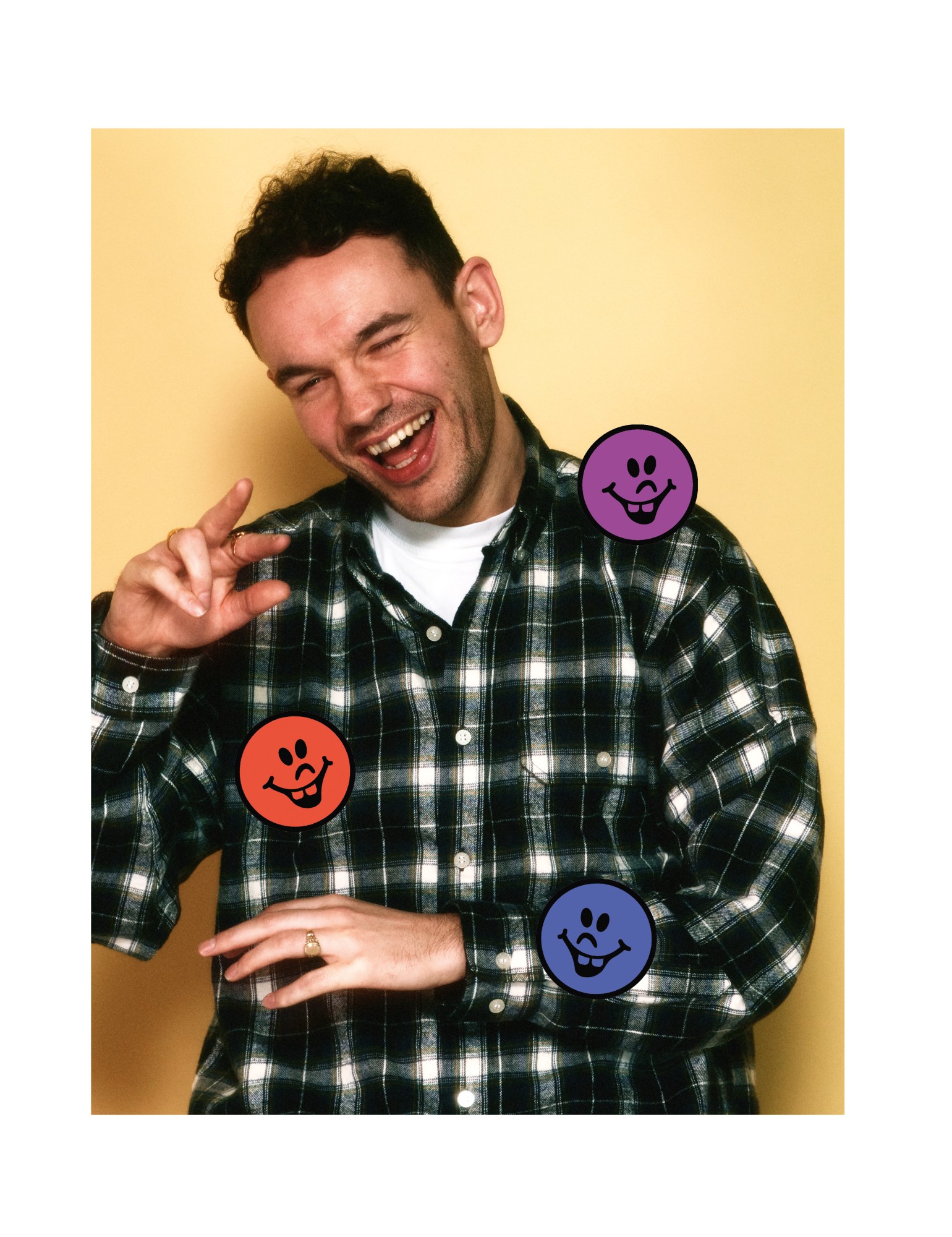
When Palace opened its Brewer Street flagship Palace London skateboards shop, several easy tenets were set out for the staff. The first rule of working at Palace is to be nice to the customers. Say ‘hello’. Never forget your ‘please’ and ‘thank yous’. Not in an obsequious way. Just to make sure people like being there. Just like Lev’s mum taught him. “That’s what makes the world go around,” Lev says. “It’s been drummed into my head since I was a kid because my mum has manners. It’s important to have a smile on your face and be nice to people.”
The shop was fitted out by a skateboarding hero of Lev’s, Toby Shuall, for the same price they spent on a TV wall to display skate videos in the Tokyo unit. Lev chose the marble floor, like a nouveau riche housewife picking fancy kitchen surfaces. The Rolls Royce grill and picture of the Queen were inherited from his parent’s Battersea restaurant, where Bros used to eat back in the day.
When the Palace brand started to exponentially expand, there was a suggestion that an outside designer, schooled in menswear ought to be brought in. Lev chose to keep it in the family, giving the head of design job to another skater and long-time collaborator, Gabriel ‘Nugget’ Pluckrose, named back in the day due to the shape of his head resembling that of a McDonald’s chicken McNugget. “I said, do you know what? I don’t trust anyone to do anything I don’t have to look at apart from him. Whether it’s socks or the colourway for a shirt, I’m going to have to go and sit beside them. I trust Nugget.”
The Palace approach to menswear is refreshingly simple. “We all sit there together,” he says. “We look at a big bit of paper and say, ‘Nah, that’s shit. That’s good. That’s banging. Wow, that is banging.’ It’s a family thing.” They like to pick at the edges of acceptability in menswear without over stretching their game. “Nobody wants to look like a jazzy tosser,” Lev notes. The affirmative decision to make the clothes you want to wear can only come from a shared eye, learned not by studying the minutiae of catwalks but by seeing the way men move and work best in clothes, together. By making the things you want to borrow off your pals.
“You’d be amazed by how many people at Palace have known each other for 20 years.” The core family deserves individual itemisation. “I don’t even like speaking about this particularly, because it’s not mine to speak about. It’s all of ours.”
Lucien Clarke is one of the original skate team members, since 2009. He was born in Jamaica, lived in Queens NYC and moved to Victoria aged 11, where he still lives to this day. Blondey McCoy was the first Palace poster boy. Chewy Cannon is one of British skateboarding’s nonpareil finest. Rory Milanes is “the one you’d want to introduce to your mum.” Jamal Smith and Shawn Powers are the only Americans who skate for Palace. Heitor Da Silva is the newest addition to the team. Kyle Wilson joined at around the same time, in 2018. Will Bankhead and Ben Drury are key figures, intertwined deep into the Palace hierarchy. Stuart Hammond, an original inhabitant of the Waterloo Palace, was the first writer to get Palace into print. The Palace Poet Laureate.
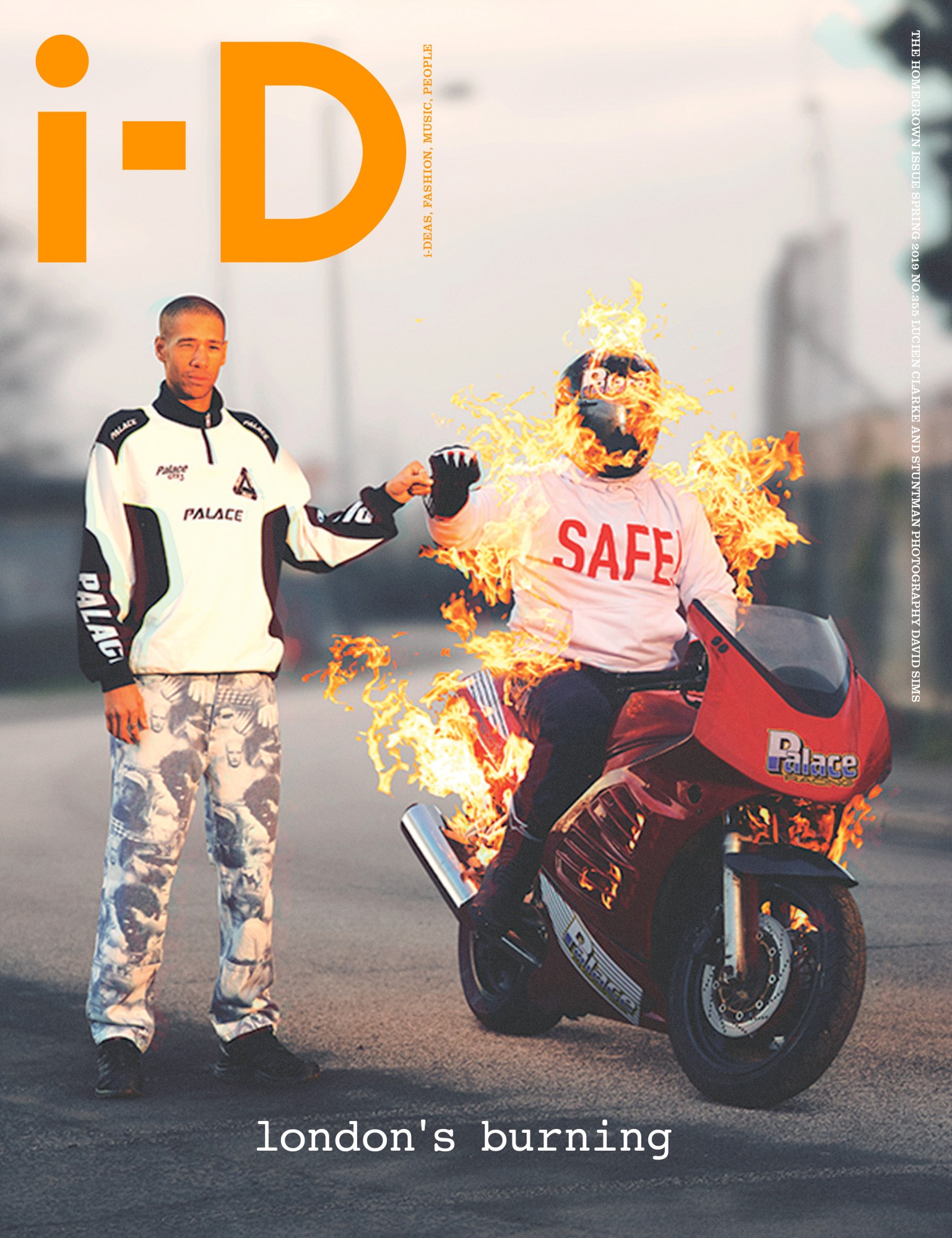
Dino Da Silva (no relation) has become assistant designer and featured face of the advertising campaigns. Dino was introduced to the Palace family by Torey Goodall, a Canadian who met the crew serendipitously while skating in New York. John Knight has worked part time at the Palace store from the start, between designing and painting for boards. Toby Shuall helped build the temporary Palace skate park in Peckham. Nugget heads up the design team. Danny Brady manages “the unmanageable” skate team. Fergus is king of their graphic universe. And Gareth Skewis is the partner and business wing who breathed life into the amazing skateboard stratosphere of Palace.
It feels like no accident that a major British rock band hasn’t emerged in the ten-year lifetime of Palace so far, to help define the look and sound of their moment. Maybe they’re it? “Er, One Direction?” Lev interjects. “They’re a band, aren’t they? They’re, like, the biggest ever.” He laughs, taking another handsome swig of champagne.
Lev Tanju will sometimes get funny reminders of the reach of Palace, the idea he first cooked up living in little more than a personally embellished squat. When he booked Tim Westwood to play the New York store opening at Cielo nightclub in the Meatpacking District, Westwood’s manager reminded him that this was his client’s first New York gig. Susan Sarandon turned up that night. Lev spent most of it chatting in the corner with his mum and his sister. That weekend the shop was road blocked, and then police cordoned. “Madness…” he recalls.
When he sees a picture of Jay-Z wearing Palace on the Daily Mail sidebar, he shrugs it off. “People have to wear shit,” he says. When he had his first meeting with Ralph Lauren about last year’s blockbuster, sell-out collaboration, he told Ralph that he had been wearing his name inside his collar for the last 30 years. One day, a kid might say the same to the Palace boys. They’d like that.
When he took his driving test recently – for the third and successful time – he struck lucky with the instructor. On telling him that he had a clothing label, he noticed a sincere interest. “Then the questions started getting easier. No reverse parking. Totally fluked it.”
Palace may be the best contemporary reminder of genuine, bona fide, street level British greatness at precisely the time we need it most. “Maybe we think about that, man,” says Lev, raconteur, bon viveur, businessman and champion of the skateboard cannon. “That’s the way we think in our office. Maybe there are times when people have to think, ‘Ugh, the pound’s just shit the bed because of Brexit. You want to stab yourself in the eye. It affects our business heavily. But we’re not sitting there scratching our nuts, saying ‘Oh fuck, what do you do now?’ We’re sitting there saying, ‘OK, let’s design the fucking Wimbledon kit. Let’s go and meet Ralph Lauren in his office. Let’s make good shit happen.’”
The waitress is hovering over the table with the bill. Lev picks it up discreetly on the way back from a smoke. “Pub?” he says.
Credits
Photography David Sims
Director Lev Tanju
Styling Gabriel Pluckrose
Text Paul Flynn
Hair Paul Hanlon at Julian Watson Agency. Make-up Lucia Pieroni at Streeters. Set design Poppy Bartlett at Magnet. Colourist Bradley Baker. Styling assistance Dino Da Silva, Julie Velut, Clemence Rose, Giulia Bandioli and Francis Plummer. Hair assistance Andrea Martinelli, Konstantinos Vrettakos, Nathan Jasztal. Make-up assistance Mirijana Vasovic. Set design assistance Roxy Walton, Daisy Azis, Mitchell Fenn and Caspar Bucknall. Set construction Cineco. Post by SKN-LAB Ltd. Production and Casting by Art House Agency. Models Rory Milanes. Jamal Smith. Heitor Da Silva. Kyle Wilson. Fergus Purcell. Toby Shaull. Jon Knight. Chewy Cannon. Lucien Clarke. Derek Lea. Anna Pearson. Hannah Ferguson at IMG. With special thanks to Ben Reardon, Sarah Dawes and Docklands Riders Club.
Models wear all clothing Palace.
